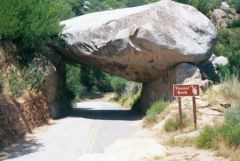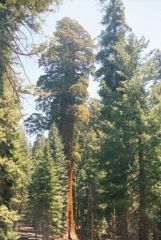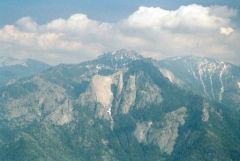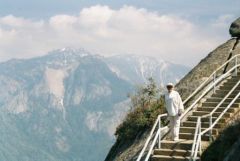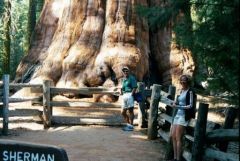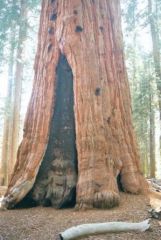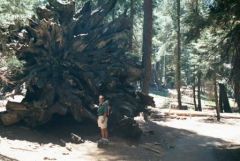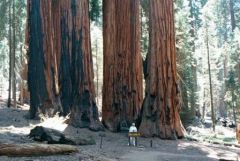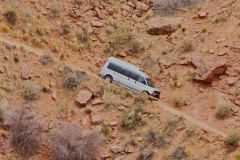-
Content Count
2713 -
Joined
-
Last visited
-
Days Won
44
Content Type
Profiles
Forums
Blogs
Gallery
Everything posted by tbutler
-
-
From the album: Big Trees - Sequoias and Redwoods
It is difficult to find a place where you can stand far enough away from a Sequoia to get the whole tree in the picture. When you get that far away it is difficult to find something to provide a sense of scale. Look at some of the other pictures to get a sense of the size. These trees are monsters, some as tall as a 25 story building and their branches can be more than six feet in diameter. How many trees have you seen that have a trunk diameter greater than six feet? I wouldn't want to be around when a branch falls, much less a whole tree!© © Tom Butler
-
From the album: Big Trees - Sequoias and Redwoods
As far as the eye can see in this photograph there is sequoia log. As you can see, it fractured when it fell. This kept the largest of these trees from being logged.© © Tom Butler
-
From the album: Big Trees - Sequoias and Redwoods
This is the view from atop Moro Rock. The climb is on stairs that weave their way through and along the sides of this granite outcrop. The climb was well worth the effort!© © Tom Butler
-
From the album: Big Trees - Sequoias and Redwoods
Louise stands on one of the wider sections of stairs leading to the top of Moro Rock. Moro Rock is one of the attractions in Sequoia National Park.© © Tom Butler
-
From the album: Big Trees - Sequoias and Redwoods
Here at the Giant Trees Museum in Sequoia NP you can get some idea of the scale of these trees. Compare the building to the tree standing in front of it. The museum is a great place to start. It has information on the life cycle of the sequoia trees. Fire is not their enemy. In fact, their seeds won't be released from their cones until the heat of a fire causes them to open. Fire clears the forest floor to allow light for the sequoias to sprout and flourish.© © Tom Butler
-
From the album: Big Trees - Sequoias and Redwoods
The General Sherman Tree is one of the largest of these giants. That is Tom standing in front of the tree. The young lady is another tourist. I decided not to cut her out of the picture since it would have cut out quite a bit of the tree.© © Tom Butler
-
From the album: Big Trees - Sequoias and Redwoods
Fire has scarred this sequoia tree but the damage doesn't stop the tree from growing. The scar will last forever but the tree lives on. As mentioned previously, fire is necessary for the survival of the sequoias.© © Tom Butler
-
From the album: Big Trees - Sequoias and Redwoods
When a tree falls in the forest... When a tree falls across the road, cut enough away to allow cars to pass beneath. In the past there were sequoias that they would allow you to drive your car (They were Model T's) up onto the fallen trunk. The National Park System is a little more restrained now.© © Tom Butler
-
From the album: Big Trees - Sequoias and Redwoods
Look carefully and you will see Louise standing next to an interpretive sign about this sequoia tree. This is another photo for scale.© © Tom Butler
-
From the album: Big Trees - Sequoias and Redwoods
Tom standing in front of the root ball of a sequoia tree.© © Tom Butler
-
From the album: Big Trees - Sequoias and Redwoods
This group of sequoias has been dubbed the Senate. A group of sequoias growing close together like this is formed from the roots of a tree that died. All are about the same age and size. Their roots will be intertwined which makes them very resistant to being blown over even though they are so extremely tall. This group is found along the Congress Trail in Sequoia National Park.© © Tom Butler
-

Our Favorite Places - Among the Giant Trees
tbutler posted a blog entry in Tom and Louise on Tour in North America
The giant sequoias and redwoods of California are trees without parallel. To walk in a forest of such magnificent size is a privilege that few people in the world have. There is no way to read about the sequoias and redwoods and truly appreciate them. Our base camp was at Visalia, CA. We hiked numerous trails in Sequoia National Park. To see trees partially burned out and still standing tall and strong was amazing. Realizing that the branches of these trees are the size of the trunks of what we would consider huge trees is also amazing. It is no wonder that loggers looked at these trees and immediately thought about the tremendous amount of wood they would provide. Unfortunately or fortunately perhaps, there is no way to fell one of these trees and get useful lumber from them. Walking up to a log in the forest provides another way to drink in the majesty of these giants. After admiring the General Sherman and Grant Trees, we hiked the Congress trail at a leisurely pace, learning more about the sequoias as we walked around and through them. The Congress Group is an impressive assemblage of giant sequoias. These trees reinforce each other through interlocking and sometimes shared roots. The Big Trees Loop Trail is a shorter trail among some very large trees. Finally one of the most spectacular view points in the park is at Moro Rock. There are rails all along the way for safety. The steep climb up stairs and ramps is not for the feint of heart. It leads to a windy spot atop a narrow bare rock. From there the view is shear rock faces and deep valleys. You get a real top-of-the-world feeling from that point. There are bears in Sequoia National Park, we saw one that retreated across the road ahead of us. We saw a few deer but wildlife is not the high point here. The trees are the stars here. In the Redwoods, we never made it to Redwood National Park but found plenty of redwoods at Humbolt Redwoods State Park and along the Old Redwood Highway. Our campground at Redcrest on the Old Redwood Highway was an excellent point from which to explore the entire Redwood area. We were in fact camped under a redwood tree in a grove of redwoods. We were a short drive from Humbolt Redwoods State Park. The redwoods are the tallest trees, towering over even the sequoias. I rode my bicycle along the old redwood highway in the early mornings feeling both insignificant and the luckiest person on Earth at the same time. We enjoyed a number of trails among the redwoods and learned much about their history and life cycle. We also drove our car through a redwood tree and explored a tree house in a redwood stump. Redwood trees can and are used for lumber so it is only through the efforts of conservationists and preservationists that the old large trees remain. There are small plots of land with redwoods throughout the area. We walked one small plot from one end to the other. Along the way there were interpretative signs. The trail was small and there were no other hikers. The feeling of being alone in a large forest all alone made one feel like a "hobbit," a tiny being in a much larger world. We saw fallen trees with new trees growing from the dead trunks lying horizontal on the ground. We stood beside root balls that were three times our height and walked along the tops of logs well above the forest floor. The scenes were magical in their beauty and we often walked in silence simply admiring the majesty of it all. The sequoias and redwoods are some of the most amazing living wonders of the natural world. -
Welcome Mike and Suzie, There was a query from a US couple looking for travel tips for Australia just a few days ago. See Has Anybody Toured Australia? for that discussion. I wonder if you might entertain exchanging RV's with someone interested in touring Australia? You are coming for the summer and they would be going for the winter but I'm sure some people would be happy with such an arrangement. Lots of us would be interested in touring Australia in an RV. If you decide to purchase an RV here, there are plenty of used RV's on the market right now. With a used RV purchased at a good price, you might be able to recover most of the purchase cost if you can be patient with the eventual sale. Otherwise, there are RV's for rent through several outlets. As to what to see, the list is so massive that no one of us could even scratch the surface. On my must see list would be things like the giant redwood and sequoia trees. The redwoods are north of San Francisco and the sequoias are south west. Both are within a days drive of San Francisco. The volcanoes of the Cascade Range are on to the north through northern California, Oregon and Washington. To the south in California, Nevada, Arizona and New Mexico are deserts. The canyons of Utah, The Grand Canyon, Bryce Canyon, Zion Canyon, and Arches National Parks are all spectacular scenery. You have expressed an interest in art and a web search will connect you with art galleries in many cities. Besides New York, there are excellent galleries in most major US cities. The distance from San Francisco to New York City is approximately 3200 miles. If you decide to make this trip you could go east along a route through the central US or southern part of the country and return through a route in the north or central part of the country. Let us know what your interests are beyond the art galleries and many of us can chip in with suggestions for things to see.
-
Given the smaller diesel engine of the front engine diesel motor home, the hydraulic brakes and smaller transmission that Brett mentions, I would be very surprised if such a coach had a higher towing capacity than a rear diesel motor home. Weight in the rear of the motor home is a non-factor when it comes to towing. The tongue weight of any load being towed will be a small fraction of the weight of the towed load. In the case of towing a car, most tow bars place almost zero weight on the coach (half the weight of the tow bar itself). Towing capacity is related to power of the engine; strength of the transmission, the chassis frame and the installed hitch receiver; and the braking ability of the towing vehicle combined with any braking contributed by the towed load. For my money, I'd just as soon have the engine in the rear. Conversation in the cockpit is quite easy. Having the generator in the front is also ideal for sleeping if you have to run the generator during the night (to charge batteries for the furnace, etc.). I find the ride and handling to be very good for a vehicle this size. Large motor homes weigh between 12 and 40 tons, depending on the type. It isn't a sports car. My front tires have more weight per square surface contact inch than my rear tires. One major factor that affects handling in wind is the length of coach that extends beyond the rear axle. This also affects the handling of the coach when large vehicles (tractor trailer trucks) pass. If handling is better with a front engine coach, I would think it would be marginally better. Think of the motor home as a very large heavy lever. The longer the coach extends beyond the rear axle, the longer the lever arm any force will push against. The fulcrum for this is the rear axle and any push on the rear will move the front in the opposite direction as it turns (or twists) around the pivot point, the rear axle. A longer lever arm makes it easier to move the coach since it multiplies the force. This factor also applies to sway caused by the toad if you have one. I feel our coach move occasionally if a large truck moving much faster than me passes. The kind of trucks that produce a large bow wake are not fuel efficient and there are fewer of them on the road today. There aren't that many windy days on the road, even driving in mountains and deserts, we've only had a handful of extreme windy days in eight years on the road. I have never noticed any sway with our coach caused by our toad. There is a recent post dealing with the issue of sway caused by a toad. I don't remember the kind of coach but I suspect it is one that has a large overhang beyond the rear axle. I would consider this a major factor related to handling of any vehicle. I'd look for a rear engine coach which has a short portion of the coach extending beyond the rear axle. Besides renting a coach for an outing, be sure to test drive any coach you are considering purchasing. In addition, test drive as many chassis types of coaches as you can before you purchase one. This will give you a better idea of how each type of coach handles. When test driving a coach, remember that it is likely very lightly loaded with only the fuel needed and no personal gear stowed. Adding weight to the coach will affect the ride, handling and performance. Balancing the load when it is finally added also has a lot to do with ride and handling.
-

Albuquerque Balloon Fiesta Park
tbutler replied to sdkiefer's topic in FMCA Albuquerque, New Mexico, 2010
You'll likely get an official answer from someone on the convention committee but here is our experience. This is based on attending a number of FMCA National Conventions. We've never been to the Balloon Fiesta Park in Albuquerque. You won't be in an RV Park as such. At most conventions you will be parked in a large field or parking lot which has no services except for those brought in for the convention. The parking committee will park you in your space next to the coach ahead of you in line with the coach behind you on the other side. If you are arriving with friends you have to be lined up together when you come onto the grounds or you'll be parked in different places. At Bowling Green last year there were several thousand member coaches and those were parked in about a day and a half. As you can imagine, this is a tremendous task so be patient with the parking crew. I've seen crews function smoothly and crews that were getting their first experience with this task. When you get an experienced crew they will have everything running like a top and the process is amazing and fun to watch. These guys are all FMCA members and are volunteers so smile - no matter what happens. When it is all done, you'll be in the middle of a city of 3000 or more people where there was nothing but an open field two days before. It's really an awesome sight. I always get up on our roof to take a picture of the gathering! We've always signed up for electric connections for a convention. The electricity is provided by generators (large mobile units) that power eight to a dozen coaches (my guess) with 30A electric. The generators are fairly quiet but if you are parked next to one, it will be a constant noise through the whole convention. On the other hand if you don't have electric, you'll have people running generators and that can get pretty noxious with everyone running their generator for the air conditioners. In March this may be less a problem than in the summer. We've never had water or sewer at a national convention. Generally you're set up on a fairgrounds that doesn't have those connections. Some places have dump stations available and there is always the honey wagon for emptying tanks. Last year at Bowling Green, OH there were shower units in central areas near coach parking. They were clean and provided a good shower which saved your fresh water and gray water tank space. Generally the coaches are parked in close proximity. You likely will have room to put out an awning but will also be expected to park your car between your coach unless you happen to be in a spot that isn't filled completely. We've had several arrangements like coaches facing each other or coaches facing the back of the line of coaches ahead. In Minneapolis we lucked into parking in the state fair campgrounds. It just happened that we were at the point in the line where they directed us into the campground. We had electric the whole time from a permanent plug-in. The campground showers were just 100 feet from our spot and we had roads to drive on, not grass. We always have our bicycles with us, we're full timers. We enjoy having the bicycles to get around the grounds. It can be quite a distance to walk and there will be shuttles provided in most cases but if you want to travel on your own, a bicycle is an excellent way to go. Generally golf carts aren't permitted for attendees. Staff and volunteers may have golf carts for official activities but the rest of us have to get there by other means. I've seen shuttles that were tractors and wagons and buses from small shuttle buses to school buses. In Bowling Green they had some six passenger golf carts for short distance shuttles where there was no convenient bus road. -
Thanks for letting us know how the problem was resolved. Now we have a solution that may work work someone else.
-

Refrigererator Error
tbutler replied to susan.charles@windstream.net's topic in Systems and Appliances
Susan and Charles, Since you have contacted Dometic and they have not been able to diagnose the problem over the phone you most likely will have to have the refrigerator physically examined at a service center. There are really two warranties when dealing with motor homes. You may not have the original manufacturers warranty on the motor home but each of the components, refrigerator, microwave, toilet, inverter, etc. may have its own warranty from its manufacturer. Thus you may find that Dometic will still honor their warranty of the refrigerator even though you are the second owner of the motor home. It is worth a try, in fact your extended warranty company may require that you use the Dometic warranty first and then after it expires their warranty coverage will kick in. In order to keep your extended warranty in effect you have to follow their rules. When Herman and Bobbie said "Follow the rules to a fault." That means that you should read the whole extended warranty very carefully. They have a whole set of requirements which are like hurdles. If you stumble on any one, you have lost the race. They usually require that you call them before any work is done. They may specify where the work is done, who does the diagnosis, etc. So before you take this to a service center, call the warranty people to discuss the problem with them. If they will cover the work, get it in to a repair center as soon as you can. Getting the work done ASAP will get the problem off your mind and will get the warranty benefit in your pocket before they find a hurdle that you haven't cleared. Be sure to mention your extended warranty when you contact the service center as there are some service centers that will not work with one warranty company or another because of previous problems or differences over payments for work done. Some warranty companies try to negotiate discounts for work done or try to pay only so much for each kind of repair. Doing the paperwork can be a hassle for the service center and they may simply refuse to work with a specific company which leaves you the choice of going to another service center or perhaps pay the bill yourself and then accept what the extended warranty company is willing to pay. When it comes to extended warranties, you must keep very complete records. Be sure that any service company puts mileage and date on any invoice and file them away in a place where you can find them when needed. Also make sure the invoices list clearly all procedures (oil changes, lubrication, adjustments, inspections) required by the warranty. If the warranty company wants, you must produce written records of satisfying all required maintenance. Most will allow you to keep a written log of any owner provided maintenance such as an oil change as long as you are trained or qualified to do the work. Anyone who purchases an extended warranty should take the time to read the actual contract very carefully before the warranty is purchased. Do not rely on the advertisement brochure that the sales person hands you, read the actual contract with all its legalese. Make notes or highlight the contract and make yourself a maintenance schedule that you can keep handy. If you wait until you have a problem to read your warranty you may have already missed one of those hurdles and lost the race. Each of their requirements for service or maintenance is an "out" for the warranty company. If you don't follow their rules, they don't have to give your warranty benefits. They have a legal contract and as long as you meet your end of the bargain, they will meet their end. -

IMG_0659 (253 of 479) - Version 2.jpg
tbutler commented on ozarkshome@mac.com's gallery image in Members Gallery
-
Hey Herman, I know what you mean about camping. I love a good gravel bar on a float trip for a campsite. Quiet, with just the sound of the water in the rapids to keep you company. I can smell the fresh fish cooking over the open fire and taste the cold beer to wash it down. The ground has gotten much harder in the last ten years! We're living in our motor home full time and the DVR (if I had one) would be here in the motor home. For us full timers, you can expect that we'll want to have all (well most of) the conveniences of home in our motor home. So yeah, we want TV every night. We have a generator and an inverter and we want AC electric on all the time in our (motor) home. We use the internet for correspondence, news, weather, finances, you name it, so we want an internet connection everywhere we go. We need to keep in touch with family and friends so we want the cell phones to work all the time. We love sitting in the lawn chairs watching the sun set with a nice bottle of wine between us. When we can't get all that, then we are camping! Sometimes we do that on purpose, sometimes we don't have any choice. I hope that when you reach your retirement you are able to experience the wonderful freedom and of traveling and living in your motor home (if you so desire). Any way you cut it though, life in a motor home beats the alternative all to pieces.
-
TV Stations haven't cut their signal strength, it is the nature of the digital signal that it doesn't transmit as far or as well. With digital you either have it or don't. There is no snowy picture when the signal is weak. So it is all or nothing. As you watch and the signal strength changes because a bat flaps its wing or a butterfly flits or a ship toots its horn, the signal fades a little and the picture goes... well... gone! Then the signal improves a little and it's back. As Jack said, there is a signal strength meter on many digital TV's. If you follow his procedure, you should get your best signal for any station. Just remember that all stations in Memphis aren't in the same location. This one is east of town, that one is on a hill to the west and another is north... That means that you may have to check the signal meter and re-align the antenna every time you change channels. And some of those stations may be 90 miles away. This is fun isn't it? Just remember now there is no snow just beautiful picture... when you can get it. I think over time many stations will set up remote antennas to improve their signal strength in remote areas. In the meantime, we'll have to cope the best we can. Good tuning...
-
It is a painful fact that the traffic engineers who program traffic lights don't always take into account the stopping time and distance for larger vehicles. Indeed, I think some traffic lights are not programmed by engineers but just done by the mayors cousin! Given this, a tip that I picked up several years ago in a safety class at an FMCA convention is to watch each traffic light as you come to it. If it has been green for a while, think of it as a stale green likely to turn yellow and prepare ahead of time. It means slowing down a little and having your finger (or foot) on the engine brake ready to pounce at the flash of a light. If you make a habit of watching the lights as you approach you'll likely be caught less often. It takes a little paradigm shift on our part, we aren't driving sports cars. We have to adjust our driving to match the vehicle. If you are in the intersection when the light is yellow and it turns red, you should not be ticketed by the laws in some states. I can't say that is true for all. We visited friends in Winnipeg a few years ago and they told us of local enforcement practices which included parking a vehicle on the roadside in construction zones. The vehicle had a camera and speed gun which photographed any speeding vehicle. Now there is a thought that will make you slow down in construction zones. They told us of that after we had arrived so I worried for several months afterward expecting a ticket in the mail for speeding in a construction zone. It's something that I try hard not to do but sometimes you get caught going a little too fast as you enter one of these and I was certain that had happened in one particular instance. It's been two years now so I guess they missed me!
-
Mikayla, Welcome to the forum. I know what you are saying about dogs liking to hang out the window and feel the breeze. I'm sure they would ride motorcycles if they could. The fact is that any object inside a moving vehicle that isn't tied down will keep moving at the same rate of speed that the vehicle is moving even if the vehicle stops suddenly as in a collision. At 35 miles per hour you are traveling the same speed as an object falling from a four story building. If the vehicle suddenly stops, any animal not secured in a safe location will hit whatever is in front of them at 35 miles per hour. I wouldn't toss a dog or cat off a four story building. That will be a serious if not fatal injury. The best you can do is to secure them in a crate which is anchored with a seat belt. I notice in your picture that you are wearing a seat belt. Good for you, everyone should wear seat belts when in any vehicle. Your dog doesn't have the ability to put on a seat belt or even know that it should be wearing one so it is up to us marginally smarter critters to take care of them. I would secure any animal in a vehicle for this reason. Keeping them in a crate also keeps them from becoming excited about something and interfering with the driver of the vehicle. I have heard of accidents caused when a dog jumped on the lap of the driver blocking their view or interfering with their ability to maneuver the vehicle. For your own safety and the safety of the pet you love, have them in a crate when traveling! As dervati says: "Training them as a puppy that a crate is a safe, comfortable place to be and normal while traveling, gives them a security blanket."
-

Lighting upgrades on Beaver Contessa
tbutler replied to terry@dandbtrucking.com's topic in Electrical
A few years ago friends were traveling with us. I noticed his tail lights were just barely visible. We got to looking and found that the inside of the light unit (reflector) was coated with dust. He gave them a good cleaning and they looked great. Next thing you knew, they were all dusty again. He sealed them with silicon and it helped but the design of those taillights was never going to keep them clean. Have you checked the inside of your lights? You might get better performance until you can find the manufacturer of the ones you want. -
If you have a residential refrigerator, you should have an augmented set of house batteries. Instead of the industry standard 4 x 6 volt batteries, most are putting in at least 6 x 6 volt batteries. This will give a little longer time between generator runs. One possible means to extend this would be to pick up some dry ice and use it to help keep the refrigerator cold. Residential refrigerators are generally better insulated and a pound of dry ice should really help keep it cold so the unit runs less and uses less electricity. Of course if you are really in the boondocks, the dry ice will give out in a day or so and you'll be running the generator more eventually. On the other hand, the propane refrigerators have proven to be an real risk for fire and eliminating them makes your motor home much safer. I'm planning on replacing our propane model with a household model when it finally gives up the ghost.


